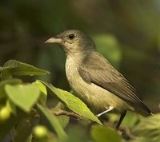
Pale-billed Flowerpecker
Encyclopedia
Tickell's Flowerpecker or Pale-billed Flowerpecker (Dicaeum erythrorhynchos) is a tiny bird that feeds on nectar and berries, found in India, Bangladesh and Sri Lanka. The bird is common especially in urban gardens with berry bearing trees. They have a rapid chipping call and the pinkish curved beak separates it from other species in the region.
_with_a_muntingia_calabura_(singapur_cherry)_fruit_w_img_8494.jpg) This is a tiny bird, 8 cm long, and is one of the smallest birds occurring in most parts of southern India and Sri Lanka. The bird is plain brownish to olive green. The underside is buff olive and does not contrast greatly with the upperparts and not whitish as in the Nilgiri Flowerpecker of the Western Ghats and Nilgiri hills nor is it streaked as in the Thick-billed Flowerpecker
This is a tiny bird, 8 cm long, and is one of the smallest birds occurring in most parts of southern India and Sri Lanka. The bird is plain brownish to olive green. The underside is buff olive and does not contrast greatly with the upperparts and not whitish as in the Nilgiri Flowerpecker of the Western Ghats and Nilgiri hills nor is it streaked as in the Thick-billed Flowerpecker
. The Nilgiri Flowerpecker has a pale supercilium unlike this species which has no marking on the head. The Sri Lankan race ceylonense Babault, 1920 - is greyer and smaller than the nominate race of peninsular India. It has been considered one of the early flowerpeckers, originating in the Malay Peninsula, to colonize the Indian Subcontinent.
(=Dendrophthoe) and Viscum
species, the seeds of which are dispersed mainly by this and other flowerpecker species. The berries of these epiphytic parasites are usually swallowed whole (they sometimes pinch fruits and discard the seeds while feeding on the pulp but this technique is more often used by the syntopic Thick-billed Flowerpecker
) and the seeds are voided after a rapid passage through their gut in about three to four minutes. The voided seed has a sticky coating and the bird applies its vent to the surface of a suitable perch and may turn around so as to get rid of the seed, which then sticks onto the branch where it may subsequently germinate. The flowers of Dendrophthoe falcata
are pollinated by this species. The flower has a mechanism that causes pollen to explosively spray on the plumage of the visiting bird.
In urban areas, they are particularly attracted to introduced fruit trees such as Muntingia calabura
, the fruits of which are swallowed whole. They also feed by crushing ripe berries and sipping the juice. They may also sip nectar from flowers such as those of Sterculia colorata
and Woodfordia floribunda, pollinating them in the process.
Description
_with_a_muntingia_calabura_(singapur_cherry)_fruit_w_img_8494.jpg)
Thick-billed Flowerpecker
The Thick-billed Flowerpecker is a tiny bird in the flowerpecker group. They feed predominantly on fruits and are active birds that are mainly seen in the tops of trees in forests...
. The Nilgiri Flowerpecker has a pale supercilium unlike this species which has no marking on the head. The Sri Lankan race ceylonense Babault, 1920 - is greyer and smaller than the nominate race of peninsular India. It has been considered one of the early flowerpeckers, originating in the Malay Peninsula, to colonize the Indian Subcontinent.
Behaviour and ecology
In forested areas, they often visit the flowers of LoranthusLoranthus
Loranthus is a genus of mostly parasitic plants that grow on the branches of woody trees. It belongs to the family Loranthaceae, the showy mistletoe family...
(=Dendrophthoe) and Viscum
Viscum
Viscum is a genus of about 70-100 species of mistletoes, native to temperate and tropical regions of Europe, Africa, Asia and Australasia. Traditionally, the genus has been placed in its own family Viscaceae, but recent genetic research by the Angiosperm Phylogeny Group shows this family to be...
species, the seeds of which are dispersed mainly by this and other flowerpecker species. The berries of these epiphytic parasites are usually swallowed whole (they sometimes pinch fruits and discard the seeds while feeding on the pulp but this technique is more often used by the syntopic Thick-billed Flowerpecker
Thick-billed Flowerpecker
The Thick-billed Flowerpecker is a tiny bird in the flowerpecker group. They feed predominantly on fruits and are active birds that are mainly seen in the tops of trees in forests...
) and the seeds are voided after a rapid passage through their gut in about three to four minutes. The voided seed has a sticky coating and the bird applies its vent to the surface of a suitable perch and may turn around so as to get rid of the seed, which then sticks onto the branch where it may subsequently germinate. The flowers of Dendrophthoe falcata
Dendrophthoe falcata
Dendrophthoe falcata Ettingsh is one of the hemiparasitic plants that belong to the Loranthaceae family of mistletoes. It is the most common of all the mistletoes that occur in India. At the moment reports say that it has around 401 plant hosts...
are pollinated by this species. The flower has a mechanism that causes pollen to explosively spray on the plumage of the visiting bird.
In urban areas, they are particularly attracted to introduced fruit trees such as Muntingia calabura
Muntingia calabura
Muntingia calabura, the sole species in the genus Muntingia, is a flowering plant native to southern Mexico, the Caribbean, Central America, and western South America south to Peru and Bolivia...
, the fruits of which are swallowed whole. They also feed by crushing ripe berries and sipping the juice. They may also sip nectar from flowers such as those of Sterculia colorata
Sterculia colorata
Scarlet Sterculia , also known as Bonfire tree, Colored Sterculia and Indian Almond and in Marathi known as "कौशी"[kaushi], is a medium-sized tree with spreading branches. It sheds leaves before the onset of flowering. After leaf-shedding, buds sprout and develop into flowers...
and Woodfordia floribunda, pollinating them in the process.

